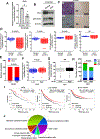GLS2 Is a Tumor Suppressor and a Regulator of Ferroptosis in Hepatocellular Carcinoma
- PMID: 35895807
- PMCID: PMC11057045
- DOI: 10.1158/0008-5472.CAN-21-3914
GLS2 Is a Tumor Suppressor and a Regulator of Ferroptosis in Hepatocellular Carcinoma
Abstract
Glutamine synthase 2 (GLS2) is a key regulator of glutaminolysis and has been previously implicated in activities consistent with tumor suppression. Here we generated Gls2 knockout (KO) mice that develop late-occurring B-cell lymphomas and hepatocellular carcinomas (HCC). Further, Gls2 KO mice subjected to the hepatocarcinogenic Stelic Animal Model (STAM) protocol produce larger HCC tumors than seen in wild-type (WT) mice. GLS2 has been shown to promote ferroptosis, a form of cell death characterized by iron-dependent accumulation of lipid peroxides. In line with this, GLS2 deficiency, either in cells derived from Gls2 KO mice or in human cancer cells depleted of GLS2, conferred significant resistance to ferroptosis. Mechanistically, GLS2, but not GLS1, increased lipid reactive oxygen species (ROS) production by facilitating the conversion of glutamate to α-ketoglutarate (αKG), thereby promoting ferroptosis. Ectopic expression of WT GLS2 in a human hepatic adenocarcinoma xenograft model significantly reduced tumor size; this effect was nullified by either expressing a catalytically inactive form of GLS2 or by blocking ferroptosis. Furthermore, analysis of cancer patient datasets supported a role for GLS2-mediated regulation of ferroptosis in human tumor suppression. These data suggest that GLS2 is a bona fide tumor suppressor and that its ability to favor ferroptosis by regulating glutaminolysis contributes to its tumor suppressive function.
Significance: This study demonstrates that the key regulator of glutaminolysis, GLS2, can limit HCC in vivo by promoting ferroptosis through αKG-dependent lipid ROS, which in turn might lay the foundation for a novel therapeutic approach.
©2022 American Association for Cancer Research.
Conflict of interest statement
Authors Disclosures
B.R.S. is an inventor on patents and patent applications involving ferroptosis, holds equity in and serves as a consultant to Inzen Therapeutics and Nevrox Limited, and serves as a consultant to Weatherwax Biotechnologies Corporation, and Akin Gump Strauss Hauer & Feld LLP.
All other authors declare no potential conflicts of interest.
Figures






References
-
- Yang L, Venneti S, Nagrath D. Glutaminolysis: A Hallmark of Cancer Metabolism. Annu Rev Biomed Eng. 2017;19:163–94. - PubMed
Publication types
MeSH terms
Substances
Grants and funding
LinkOut - more resources
Full Text Sources
Medical
Molecular Biology Databases
Research Materials
Miscellaneous

